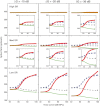Modeling the anti-masking effects of the olivocochlear reflex in auditory nerve responses to tones in sustained noise
- PMID: 22286536
- PMCID: PMC3298613
- DOI: 10.1007/s10162-011-0310-3
Modeling the anti-masking effects of the olivocochlear reflex in auditory nerve responses to tones in sustained noise
Abstract
The medial olivocochlear reflex (MOCR) has been hypothesized to provide benefit for listening in noise. Strong physiological support for an anti-masking role for the MOCR has come from the observation that auditory nerve (AN) fibers exhibit reduced firing to sustained noise and increased sensitivity to tones when the MOCR is elicited. The present study extended a well-established computational model for normal-hearing and hearing-impaired AN responses to demonstrate that these anti-masking effects can be accounted for by reducing outer hair cell (OHC) gain, which is a primary effect of the MOCR. Tone responses in noise were examined systematically as a function of tone level, noise level, and OHC gain. Signal detection theory was used to predict detection and discrimination for different spontaneous rate fiber groups. Decreasing OHC gain decreased the sustained noise response and increased maximum discharge rate to the tone, thus modeling the ability of the MOCR to decompress AN fiber rate-level functions. Comparing the present modeling results with previous data from AN fibers in decerebrate cats suggests that the ipsilateral masking noise used in the physiological study may have elicited up to 20 dB of OHC gain reduction in addition to that inferred from the contralateral noise effects. Reducing OHC gain in the model also extended the dynamic range for discrimination over a wide range of background noise levels. For each masker level, an optimal OHC gain reduction was predicted (i.e., where maximum discrimination was achieved without increased detection threshold). These optimal gain reductions increased with masker level and were physiologically realistic. Thus, reducing OHC gain can improve tone-in-noise discrimination even though it may produce a “hearing loss” in quiet. Combining MOCR effects with the sensorineural hearing loss effects already captured by this computational AN model will be beneficial for exploring the implications of their interaction for the difficulties hearing-impaired listeners have in noisy situations.
Figures












References
Publication types
MeSH terms
Grants and funding
LinkOut - more resources
Full Text Sources
Other Literature Sources
Medical
Miscellaneous

